Submitted:
13 March 2023
Posted:
14 March 2023
You are already at the latest version
Abstract
Keywords:
1. Introduction
2. Materials and Methods
2.1. Description of Monitoring Sites
2.2. PM Sample Collection
2.3. Meteorological Conditions during Measurements
2.4. Chemical Analyses
- Water soluble inorganic compounds
- Metal elements
- Carbonaceous elements
2.5. Methods for Identifying and Quantifying Air Pollution Sources
2.5.1. Principal Component Analysis (PCA)
2.5.2. Positive Matrix Factorization (PMF)
3. Results and Discussion
3.1. Aerosol Chemical Mass Concentrations
3.2. Identification and Apportionment of Sources
3.2.1. Enrichment Factor Calculations
3.2.2. PCA for Source Identification
3.2.3. Source Apportionment via PMF
Bamako
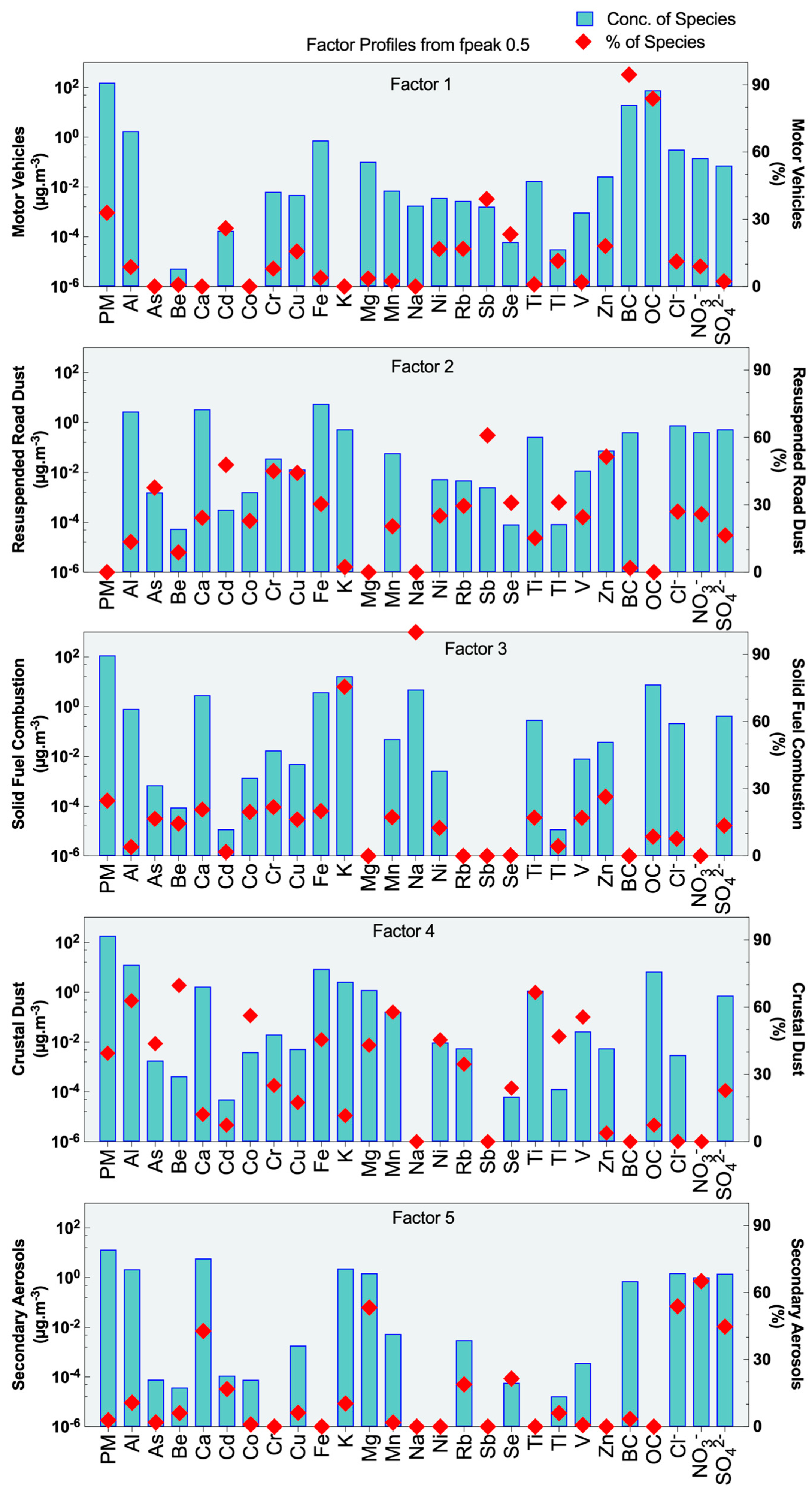
Dakar
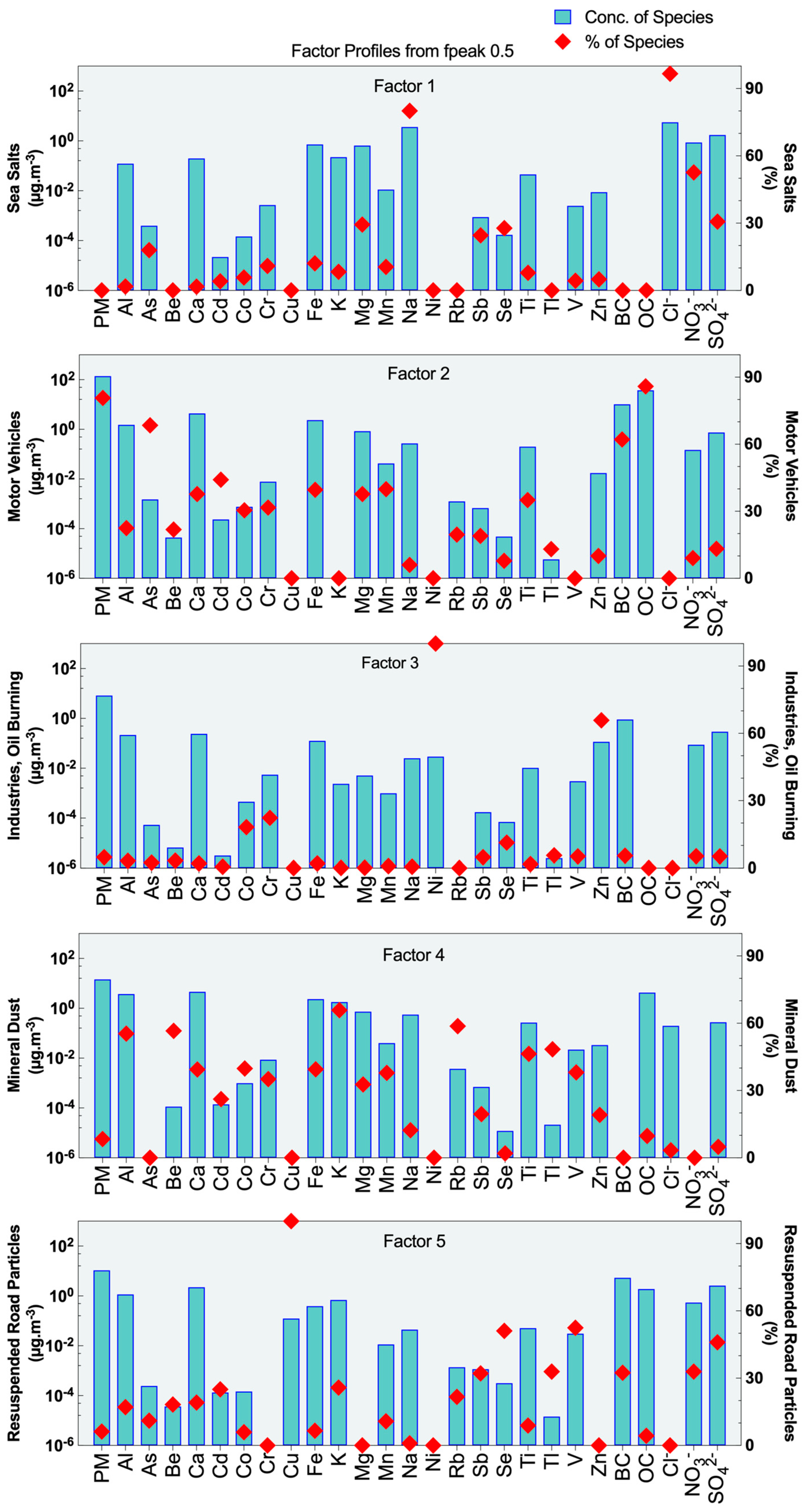
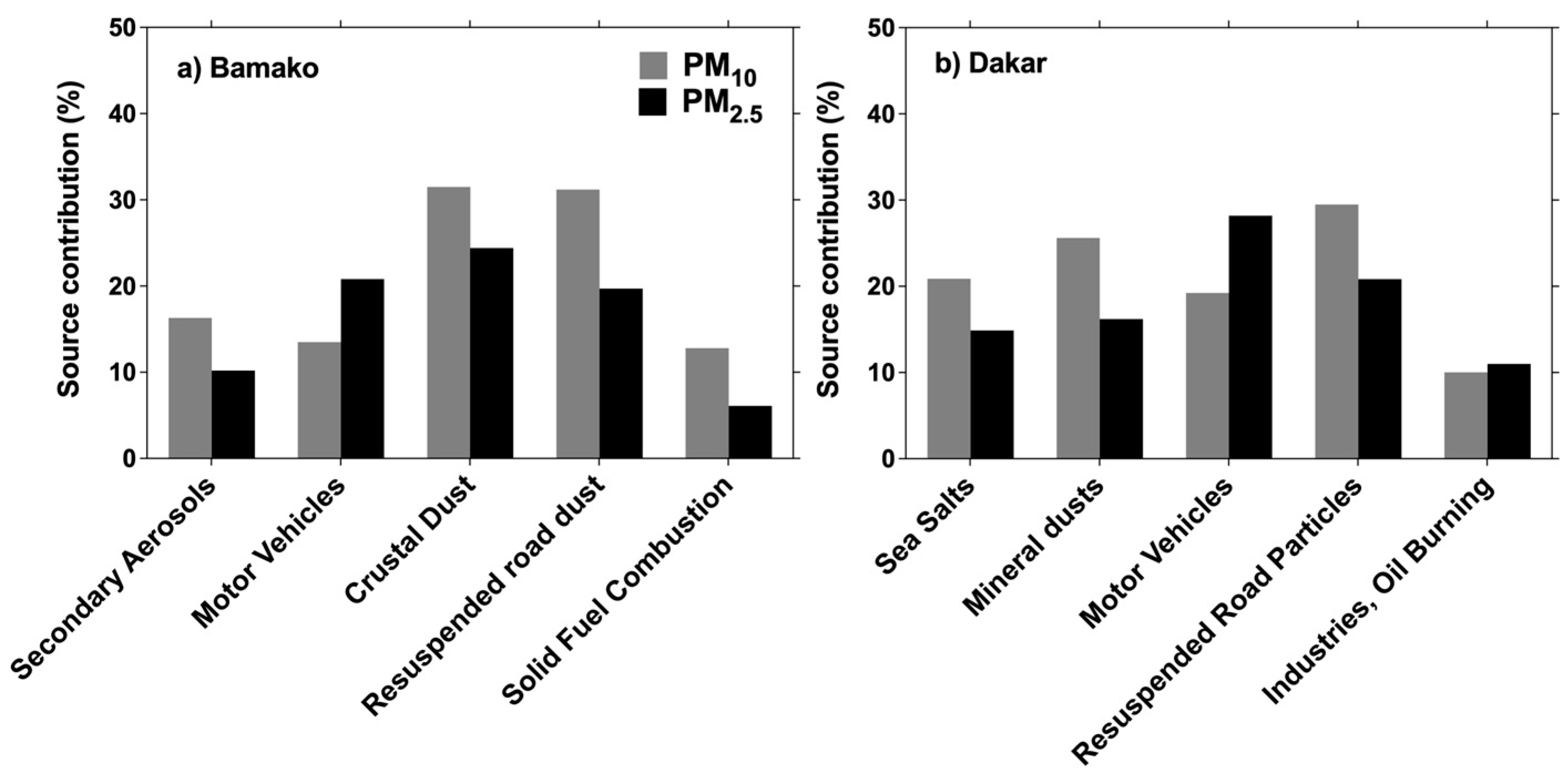
4. Conclusions
Supplementary Materials
Author Contributions
Funding
Institutional Review Board Statement
Informed Consent Statement
Data Availability Statement
Acknowledgments
Conflicts of Interest
References
- Dockery, D.W.; Pope, C.A. Acute Respiratory Effects of Particulate Air Pollution. Annual Review of Public Health, 1994, 15, 107–132. [Google Scholar] [CrossRef]
- Pope, C.A.; 3rd, Burnett, R.T.; Thun, M.J.; Calle, E.E.; Krewski, D.; Ito, K.; Thurston, G.D. Lung cancer, cardiopulmonary mortality, and long-term exposure to fine particulate air pollution. JAMA 2002, 287, 1132–1141. [Google Scholar] [CrossRef]
- Hamanaka, RB; Mutlu, GM. Particulate Matter Air Pollution: Effects on the Cardiovascular System. Front Endocrinol (Lausanne), 2018, 9:680. doi: 10.3389/fendo.2018.00680. PMID: 30505291; PMCID: PMC6250783.
- IPCC, 2007: Climate Change 2007: Synthesis Report. Geneva: IPCC. ISBN 2-9169-122-4.
- Huang, S.-L.; Hsu, M.-K.; Chan, C.-C. Effects of Submicrometer Particle Compositions on Cytokine Production and Lipid Peroxidation of Human Bronchial Epithelial Cells. Environmental Health Perspectives, 2007, 111, 478–482. [Google Scholar] [CrossRef]
- Seagrave, J.; McDonald, J.D.; Bedrick, E.; Edgerton, E.S.; Gigliotti, A.P.; Jansen, J.J.; Ke, L.; Naeher, L.P.; Seilkop, S.K.; Zheng, M.; Mauderly, J.L. Lung toxicity of ambient particulate matter from southeastern U.S. sites with different contributing sources: relationships between composition and effects. Environ. Health Perspect., 2006, 114, 1387–1393. [Google Scholar] [CrossRef]
- Happo, M.S.; Hirvonen, M.-R.; Halinen, A.I.; Jalava, P.I.; Pennanen, A.S.; Sillanpaa, M.; Hillamo, R.; Salonen, R.O. Chemical compositions responsible for inflammation and tissue damage in the mouse lung by coarse and fine particulate samples from contrasting air pollution in Europe. Inhal. Toxicol., 2008, 20, 1215–1231. [Google Scholar] [CrossRef]
- Val, S.; Liousse, C.; Doumbia, E.H.T.; Galy-Lacaux, C.; Cachier, H.; Marchand, N.; Badel, A.; Gardrat, E.; Sylvestre, A. , Baeza-Squiban, A. Physico-chemical characterization of African urban aerosols (Bamako in Mali and Dakar in Senegal) and their toxic effects in human bronchial epithelial cells: description of a worrying situation. Particle and Fibre Toxicology, 2013, 10, 10. [Google Scholar] [CrossRef]
- Arku, R.E.; Vallarino, J.; Dionisio, K.L.; Willis, R.; Choi, H.; Wilson, J.G.; Hemphill, C.; Agyei-Mensah, S.; Spengler, J.D.; Ezzati, M. Characterizing air pollution in two low-income neighborhoods in Accra, Ghana. Science of The Total Environment, 2008, 402, 217–231. [Google Scholar] [CrossRef]
- Kouassi, K.S.; Billet, S.; Garçon, G.; Verdin, A.; Diouf, A.; Cazier, F.; Djaman, J.; Courcot, D.; Shirali, P. Oxidative damage induced in A549 cells by physically and chemically characterized air particulate matter (PM2.5) collected in Abidjan, Côte d’Ivoire. Journal of Applied Toxicology, 2010, 30, 310–320. [Google Scholar] [CrossRef]
- Weinstein, J.P.; Hedges, S.R.; Kimbrough, S. Characterization and aerosol mass balance of PM2.5 and PM10 collected in Conakry, Guinea during the 2004 Harmattan period. Chemosphere, 2010, 78, 980–988. [Google Scholar] [CrossRef]
- Dionisio, K.L.; Rooney, M.S.; Arku, R.E.; Friedman, A.B.; Hughes, A.F.; Vallarino, J.; Agyei-Mensah, S.; Spengler, J.D.; Ezzati, M. Within-Neighborhood Patterns and Sources of Particle Pollution: Mobile Monitoring and Geographic Information System Analysis in Four Communities in Accra, Ghana. Environmental Health Perspectives, 2010, 118, 607–613. [Google Scholar] [CrossRef]
- Assamoi, E.-M.; Liousse, C. A new inventory for two-wheel vehicle emissions in West Africa for 2002. Atmospheric Environment, 2010, 44, 3985–3996. [Google Scholar] [CrossRef]
- Doumbia, E.H.T.; Liousse, C.; Galy-Lacaux, C.; Ndiaye, S.A.; Diop, B.; Ouafo, M.; Assamoi, E.M.; Gardrat, E.; Castera, P.; Rosset, R.; Akpo, A.; Sigha, L. Real time black carbon measurements in West and Central Africa urban sites. Atmospheric Environment, 2012, 54, 529–537. [Google Scholar] [CrossRef]
- Mukherjee, A.; Agrawal, M. World air particulate matter: sources, distribution and health effects. Environ Chem Lett, 2017; 15, 283–309. [Google Scholar] [CrossRef]
- Bertrand, J.; Baudet, J.; Drochon, A. Importance des aérosols naturels en Afrique de l’Ouest. Journal de Recherhce Atmosphérique, 1974, 8, 845–860. [Google Scholar]
- Asubiojo, O.I.; Obioh, I.B.; Oluyemi, E.A.; Oluwole, A.F.; Spyrou, N.M.; Farooqi, A.S.; Arshed, W.; Akanle, O.A. Elemental characterization of airborne particulates at two Nigerian locations during the Harmattan season. Journal of Radioanalytical and Nuclear Chemistry Articles, 1993, 167, 283–293. [Google Scholar] [CrossRef]
- Eltayeb, M.A.H.; Injuk, J.; Maenhaut, W.; Van Grieken, R.E. Elemental composition of mineral aerosol generated from Sudan Sahara sand. Journal of atmospheric chemistry, 2001; 40, 247–273. [Google Scholar] [CrossRef]
- Gnamien, S.; Yoboué, V.; Liousse, C.; Ossohou, M.; Keita, S.; Bahino, J.; Siélé, S.; Diaby, L. Particulate Pollution in Korhogo and Abidjan (Cote d’Ivoire) during the Dry Season. Aerosol Air Qual. Res., 2021, 21, 200201. [Google Scholar] [CrossRef]
- Larsen, R.K.; Baker, J.E. Source Apportionment of Polycyclic Aromatic Hydrocarbons in the Urban Atmosphere: A Comparison of Three Methods. Environ. Sci. Technol., 2003, 37, 1873–1881. [Google Scholar] [CrossRef]
- Yang, H.; Yu, J.Z.; Ho, S.S.H.; Xu, J.; Wu, W.-S.; Wan, C.H.; Wang, Xiaodong; Wang, Xiaorong; Wang, L. The chemical composition of inorganic and carbonaceous materials in PM2.5 in Nanjing, China. Atmospheric Environment 2005, 39, 3735–3749. [Google Scholar] [CrossRef]
- Xu, L.; Chen, X.; Chen, J.; Zhang, F.; He, C.; Du, K.; Wang, Y. Characterization of PM10 atmospheric aerosol at urban and urban background sites in Fuzhou city, China. Environmental Science and Pollution Research, 2012, 19, 1443–1453. [Google Scholar] [CrossRef]
- Gordon, G.E. Receptor models. Environ. Sci. Technol., 1991, 22, 1132–1142. [Google Scholar] [CrossRef]
- Hopke, P.K. An introduction to receptor modeling. Chemometrics and Intelligent Laboratory Systems, 1991, 10, 21–43. [Google Scholar] [CrossRef]
- Paatero, P.; Tapper, U. Analysis of different modes of factor analysis as least squares fit problems. Chemometrics and Intelligent Laboratory Systems, 1993, 18, 183–194. [Google Scholar] [CrossRef]
- Watson, J.G.; Chow, J.C. Particulate pattern recognition. In Introduction to Environmental Forensics, Murphy, B. L.; Morrison, R., Eds.; Academic Press: New York, NY, 2002, pp. 429-460.
- Zhang, R.; Han, Z.; Shen, Z.; Cao, J. Continuous measurement of number concentrations and elemental composition of aerosol particles for a dust storm event in Beijing. Advances in Atmospheric Sciences, 2008, 25, 89–95. [Google Scholar] [CrossRef]
- Adon, M.; Yoboue, V.; Galy-Lacaux, C.; Liousse, C.; Diop, B.; Doumbia, E.H.T.; Gardrat, E.; and Ndiaye, S.A. , 2016. Measurements of NO2, SO2, NH3, HNO3 and O3 in West Africa urban environments. Atmospheric Environment, 2016, 135, 31–40. [Google Scholar] [CrossRef]
- RGPH, Recensement Général de la Population et de l'Habitat du Mali. Institut National de la Statistique (INSTAT), 2009, https://demostaf.web.ined.fr/index.php/catalog/348.
- ANSD, Agence National de la Statistique et de la Démographie. Rapport national sur la Situation économique et sociale du Sénégal, Démographie, Edition 2009, https://www.ansd.sn/ressources/ses/chapitres/1-Demographie_2009.pdf.
- Ouafo-Leumbe, M.R.; Galy-Lacaux, C.; Liousse, C.; Pont, V.; Akpo, A.; Doumbia, E.H.T.; Gardrat, E.; Zouiten, C.; Sigha-Nkamdjou, L.; Edkodeck, G.E. Chemical composition and sources of atmospheric aerosols at Djougou (Benin). Meteorol. Atmos. Phys., 2018, 130, 591–609. [Google Scholar] [CrossRef]
- Lyamani, H.; Olmo, F.J.; Alados-Arboledas, L. Light scattering and absorption properties of aerosol particles in the urban environment of Granada, Spain. Atmospheric Environment, 2008, 42, 2630–2642. [Google Scholar] [CrossRef]
- Esteve, A.R.; Estellés, V.; Utrillas, M.P.; Martínez-Lozano, J.A. In-situ integrating nephelometer measurements of the scattering properties of atmospheric aerosols at an urban coastal site in western Mediterranean. Atmospheric Environment, 2012, 47, 43–50. [Google Scholar] [CrossRef]
- Adon, M.; Galy-Lacaux, C.; Yoboué, V.; Delon, C.; Lacaux, J.P.; Castera, P.; Gardrat, E.; Pienaar, J.; Al Ourabi, H.; Laouali, D.; others. Long term measurements of sulfur dioxide, nitrogen dioxide, ammonia, nitric acid and ozone in Africa using passive samplers. Atmos. Chem. Phys, 2010, 10, 7467-7487. [CrossRef]
- Alleman, L.Y.; Lamaison, L.; Perdrix, E.; Robache, A.; Galloo, J.-C. PM10 metal concentrations and source identification using positive matrix factorization and wind sectoring in a French industrial zone. Atmospheric Research, 2010, 96, 612–625. [Google Scholar] [CrossRef]
- Celo, V.; Dabek-Zlotorzynska, E.; Mathieu, D.; Okonskaia, I. Validation of simple microwave-assisted acid digestion method using microvessels for analysis of trace elements in atmospheric PM2.5 in monitoring and fingerprinting studies. The Open Chemical & Biomedical Methods Journal, 2010, 3, 141–150. [Google Scholar]
- Cachier, H.; Brémond, M.P.; Buat-Ménard, P. Determination of atmospheric soot carbon with a simple thermal method. Tellus Series B-Chemical and Physical Meteorology, 1989, 41(B), 379-390. [CrossRef]
- Chow, J.C.; Watson, J.G.; Pritchett, L.C.; Pierson, W.R.; Frazier, C.A.; Purcell, R.G. The DRI thermal/optical reflectance carbon analysis system: description, evaluation and applications in U.S. Air quality studies. Atmospheric Environment. Part A. General Topics, 1993, 27, 1185–1201. [Google Scholar] [CrossRef]
- Schmid, H.; Laskus, L.; Jürgen Abraham, H.; Baltensperger, U.; Lavanchy, V.; Bizjak, M.; Burba, P.; Cachier, H.; Crow, D.; Chow, J.; Gnauk, T.; Even, A.; ten Brink, H.; Giesen, K.-P.; Hitzenberger, R.; Hueglin, C.; Maenhaut, W.; Pio, C.; Carvalho, A.; Putaud, J.-P.; Toom-Sauntry, D.; Puxbaum, H. Results of the “carbon conference” international aerosol carbon round robin test stage I. Atmospheric Environment, 2001, 35, 2111–2121. [Google Scholar] [CrossRef]
- Hitzenberger, R.; Petzold, A.; Bauer, H.; Ctyroky, P.; Pouresmaeil, P.; Laskus, L.; Puxbaum, H. Intercomparison of Thermal and Optical Measurement Methods for Elemental Carbon and Black Carbon at an Urban Location. Environ. Sci. Technol., 2006, 40, 6377–6383. [Google Scholar] [CrossRef]
- Paatero, P.; Tapper, U. Positive matrix factorization: A non-negative factor model with optimal utilization of error estimates of data values. Environmetrics, 1994, 5, 111–126. [Google Scholar] [CrossRef]
- Polissar, A.V.; Hopke, P.K.; Poirot, R.L. Atmospheric Aerosol over Vermont: Chemical Composition and Sources. Environ. Sci. Technol., 2001, 35, 4604–4621. [Google Scholar] [CrossRef]
- Paatero, P.; Hopke, P.K. Discarding or downweighting high-noise variables in factor analytic models. Analytica Chimica Acta, 2003, 490, 277–289. [Google Scholar] [CrossRef]
- Song, Y.; Xie, S.; Zhang, Y.; Zeng, L.; Salmon, L.G.; Zheng, M. Source apportionment of PM2.5 in Beijing using principal component analysis/absolute principal component scores and UNMIX. Science of The Total Environment, 2006, 372, 278–286. [Google Scholar] [CrossRef]
- Gupta, I.; Salunkhe, A.; Kumar, R. Source Apportionment of PM10 by Positive Matrix Factorization in Urban Area of Mumbai, India. Scientific World Journal, 2012.
- Draxler, R.R. and Hess, G.D. An overview of the HYSPLIT_4 modelling system for trajectories, dispersion, and deposition. Aust. Meteorol. Mag., 1998, 47, 295–308. [Google Scholar]
- Adon, A.J.; Liousse, C.; Doumbia, E.H.T.; Baeza-Squiban, A.; Cachier, H.; Léon, J.-F.; Yoboue, V.; Akpo, A.B.; Galy-Lacaux, C.; Zoutien, C.; Xu, H.; Gardrat, E.; Keita, S. Physico-chemical characterization of urban aerosols from specific combustion sources in West Africa at Abidjan in Côte d’Ivoire and Cotonou in Benin in the frame of DACCIWA program. Atmospheric Chem. Phys. Discuss. 2019; 1–69. [Google Scholar] [CrossRef]
- Putaud, J.-P.; Raes, F.; Van Dingenen, R.; Brüggemann, E.; Facchini, M.-C.; Decesari, S.; Fuzzi, S.; Gehrig, R.; Hüglin, C.; Laj, P.; Lorbeer, G.; Maenhaut, W.; Mihalopoulos, N.; Müller, K.; Querol, X.; Rodriguez, S.; Schneider, J.; Spindler, G.; Brink, H. ten; Tørseth, K.; Wiedensohler, A. A European aerosol phenomenology-2: chemical characteristics of particulate matter at kerbside, urban, rural and background sites in Europe. Atmospheric Environment, 2004, 38, 2579–2595. [Google Scholar] [CrossRef]
- Querol, X.; Alastuey, A.; Viana, M.M.; Rodriguez, S.; Artiñano, B.; Salvador, P.; Garcia do Santos, S.; Fernandez Patier, R.; Ruiz, C.R.; de la Rosa, J.; Sanchez de la Campa, A.; Menendez, M.; Gil, J.I. Speciation and origin of PM10 and PM2.5 in Spain. Journal of Aerosol Science, 2004, 35, 1151–1172. [Google Scholar] [CrossRef]
- Yu, J.Z.; Tung, J.W.T.; Wu, A.W.M.; Lau, A.K.H.; Louie, P.K.-K.; Fung, J.C.H. Abundance and seasonal characteristics of elemental and organic carbon in Hong Kong PM10. Atmospheric Environment, 2004, 38, 1511–1521. [Google Scholar] [CrossRef]
- McLennan, S.M. Relationships between the trace element composition of sedimentary rocks and upper continental crust. Geochem. Geophys. Geosyst., 2001, 2, 1021–24. [Google Scholar] [CrossRef]
- Dongarrà, G.; Manno, E.; Varrica, D.; Vultaggio, M. Mass levels, crustal component and trace elements in PM10 in Palermo, Italy. Atmospheric Environment, 2007, 41, 7977–7986. [Google Scholar] [CrossRef]
- Nyanganyura, D.; Maenhaut, W.; Mathuthu, M.; Makarau, A.; Meixner, F.X. The chemical composition of tropospheric aerosols and their contributing sources to a continental background site in northern Zimbabwe from 1994 to 2000. Atmospheric Environment, 2007, 41, 2644–2659. [Google Scholar] [CrossRef]
- Zheng, M.; Salmon, L.G.; Schauer, J.J.; Zeng, L.; Kiang, C.S.; Zhang, Y.; Cass, G.R. Seasonal trends in PM2.5 source contributions in Beijing, China. Atmospheric Environment, 2005, 39, 3967–3976. [Google Scholar] [CrossRef]
- Guinot, B.; Cachier, H.; Sciare, J.; Tong, Y.; Xin, W.; Jianhua, Y. Beijing aerosol: Atmospheric interactions and new trends. J. Geophys. Res., 2007, 112, D14314. [Google Scholar] [CrossRef]
- Sandradewi, J.; Prévôt, A.S.H.; Weingartner, E.; Schmidhauser, R.; Gysel, M.; Baltensperger, U. A study of wood burning and traffic aerosols in an Alpine valley using a multi-wavelength Aethalometer. Atmospheric Environment, 2008, 42, 101–112. [Google Scholar] [CrossRef]
- Pio, C.; Cerqueira, M.; Harrison, R.M.; Nunes, T.; Mirante, F.; Alves, C.; Oliveira, C.; Sanchez de la Campa, A.; Artíñano, B.; Matos, M. OC/EC ratio observations in Europe: Re-thinking the approach for apportionment between primary and secondary organic carbon. Atmospheric Environment, 2011, 45, 6121–6132. [Google Scholar] [CrossRef]
- Sternbeck, J.; Sjödin, Å.; Andréasson, K. Metal emissions from road traffic and the influence of resuspension-results from two tunnel studies. Atmospheric Environment, 2002, 36, 4735–4744. [Google Scholar] [CrossRef]
- Thorpe, A.; Harrison, R.M. Sources and properties of non-exhaust particulate matter from road traffic: a review. Sci. Total Environ., 2008, 400, 270–282. [Google Scholar] [CrossRef]
- Bukowiecki, N.; Lienemann, P.; Hill, M.; Furger, M.; Richard, A.; Amato, F.; Prévôt, A.S.H.; Baltensperger, U.; Buchmann, B.; Gehrig, R. PM10 emission factors for non-exhaust particles generated by road traffic in an urban street canyon and along a freeway in Switzerland. Atmospheric Environment, 2010, 44, 2330–2340. [Google Scholar] [CrossRef]
- Amato, F.; Pandolfi, M.; Moreno, T.; Furger, M.; Pey, J.; Alastuey, A.; Bukowiecki, N.; Prevot, A.S.H.; Baltensperger, U.; Querol, X. Sources and variability of inhalable road dust particles in three European cities. Atmospheric Environment, 2011, 45, 6777–6787. [Google Scholar] [CrossRef]
- Watson, J.G.; Chow, J.C. Source characterization of major emission sources in the Imperial and Mexicali Valleys along the US/Mexico border. Science of The Total Environment, 2001, 276, 33–47. [Google Scholar] [CrossRef]
- Adepetu, J.A.; Asubiojo, O.I.; Iskander, F.Y.; Bauer, T.L. Elemental composition of Nigerian harmattan dust. Journal of radioanalytical and nuclear chemistry, 1988, 121, 141–147. [Google Scholar] [CrossRef]
- Almeida, S.M.; Pio, C.A.; Freitas, M.C.; Reis, M.A.; Trancoso, M.A. Source apportionment of fine and coarse particulate matter in a sub-urban area at the Western European Coast. Atmospheric Environment, 2005, 39, 3127–3138. [Google Scholar] [CrossRef]
- Liousse, C.; Galy-Lacaux, C. Urban pollution in West Africa. La Météorologie, 2010.
- Seinfeld, J.H.; Pandis, S.N. Atmospheric chemistry and physics: from air pollution to climate change, Wiley, 2006, New York.
- Millero, F.J.; Feistel, R.; Wright, D.G.; McDougall, T.J. The composition of Standard Seawater and the definition of the Reference-Composition Salinity Scale. Deep Sea Research Part I: Oceanographic Research Papers, 2008, 55, 50–72. [Google Scholar] [CrossRef]
- Yuan, Z.; Lau, A.K.H.; Zhang, H.; Yu, J.Z.; Louie, P.K.K.; Fung, J.C.H. Identification and spatiotemporal variations of dominant PM10 sources over Hong Kong. Atmospheric Environment, 2006, 40, 1803–1815. [Google Scholar] [CrossRef]
- Watson, J. Desert Research Institute, Protocol for Applying and Validating the CMB Model for PM2.5 and VOC. US Environmental Protection Agency, Air Quality Modeling Group, 2004. [Google Scholar]
- Allen, J.O.; Mayo, P.R.; Hughes, L.S.; Salmon, L.G.; Cass, G.R. Emissions of size-segregated aerosols from on-road vehicles in the Caldecott tunnel. Environ. Sci. Technol., 2001, 35, 4189–4197. [Google Scholar] [CrossRef]
- Pacyna, J.M.; Pacyna, E.G. An assessment of global and regional emissions of trace metals to the atmosphere from anthropogenic sources worldwide. Environmental Reviews, 2001, 9, 269–298. [Google Scholar] [CrossRef]
- Petaloti, C.; Triantafyllou, A.; Kouimtzis, T.; Samara, C. Trace elements in atmospheric particulate matter over a coal burning power production area of western Macedonia, Greece. Chemosphere, 2006, 65, 2233–2243. [Google Scholar] [CrossRef]
- Lee, S.; Liu, W.; Wang, Y.; Russell, A.G.; Edgerton, E.S. Source apportionment of PM2.5: Comparing PMF and CMB results for four ambient monitoring sites in the southeastern United States. Atmospheric Environment, 2008, 42, 4126–4137. [Google Scholar] [CrossRef]
- Cohen, D.D.; Crawford, J.; Stelcer, E.; Bac, V.T. Characterisation and source apportionment of fine particulate sources at Hanoi from 2001 to 2008. Atmospheric Environment, 2010, 44, 320–328. [Google Scholar] [CrossRef]
- Pakkanen, T.A.; Kerminen, V.-M.; Korhonen, C.H.; Hillamo, R.E.; Aarnio, P.; Koskentalo, T.; Maenhaut, W. Urban and rural ultrafine (PM0.1) particles in the Helsinki area. Atmospheric Environment, 2001, 35, 4593–4607. [Google Scholar] [CrossRef]
- Swami, K.; Judd, C.D.; Orsini, J.; Yang, K.X.; Husain, L. Microwave assisted digestion of atmospheric aerosol samples followed by inductively coupled plasma mass spectrometry determination of trace elements. Fresenius J. Anal. Chem., 2001, 369, 63–70. [Google Scholar] [CrossRef]
- Sandroni, V. and Smith, C.M. Microwave digestion of sludge, soil and sediment samples for metal analysis by inductively coupled plasma–atomic emission spectrometry. Analytica Chimica Acta, 2002, 468, 335–344. [Google Scholar] [CrossRef]
- Andreae, M.O.; Browell, E.V.; Garstang, M.; Gregory, G.L.; Harriss, R.C.; Hill, G.F.; Jacob, D.J.; Pereira, M.C.; Sachse, G.W.; Setzer, A.W.; Dias, P.L.S.; Talbot, R.W.; Torres, A.L.; Wofsy, S.C. Biomass-burning emissions and associated haze layers over Amazonia. J. Geophys. Res., 1988, 93, 1509–1527. [Google Scholar] [CrossRef]
- Chow, J.C.; Watson, J.G.; Chen, L.-W.A.; Chang, M.-C.O.; Miranda, G.P. Comparison of the DRI/OGC and Model 2001 Thermal/Optical Carbon Analyzers, 2005.
- Andreae, M.O. and Gelencsér, A. Black carbon or brown carbon? The nature of light-absorbing carbonaceous aerosols. Atmospheric Chemistry and Physics Discussions, 2006, 6, 3419–3463. [Google Scholar] [CrossRef]
- Cheng, Y.; Zheng, M.; He, K.; Chen, Y.; Yan, B.; Russell, A.G.; Shi, W.; Jiao, Z.; Sheng, G.; Fu, J.; Edgerton, E.S. Comparison of two thermal-optical methods for the determination of organic carbon and elemental carbon: Results from the southeastern United States. Atmospheric Environment, 2011, 45, 1913–1918. [Google Scholar] [CrossRef]
- Sciare, J.; Oikonomou, K.; Favez, O.; Markaki, Z.; Liakakou, E.; Cachier, H.; Mihalopoulos, N. and al. Long-term measurements of carbonaceous aerosols in the Eastern Mediterranean: evidence of long-range transport of biomass burning. Atmospheric Chemistry and Physics Discussions, 2008, 8, 6949–6982. [Google Scholar] [CrossRef]
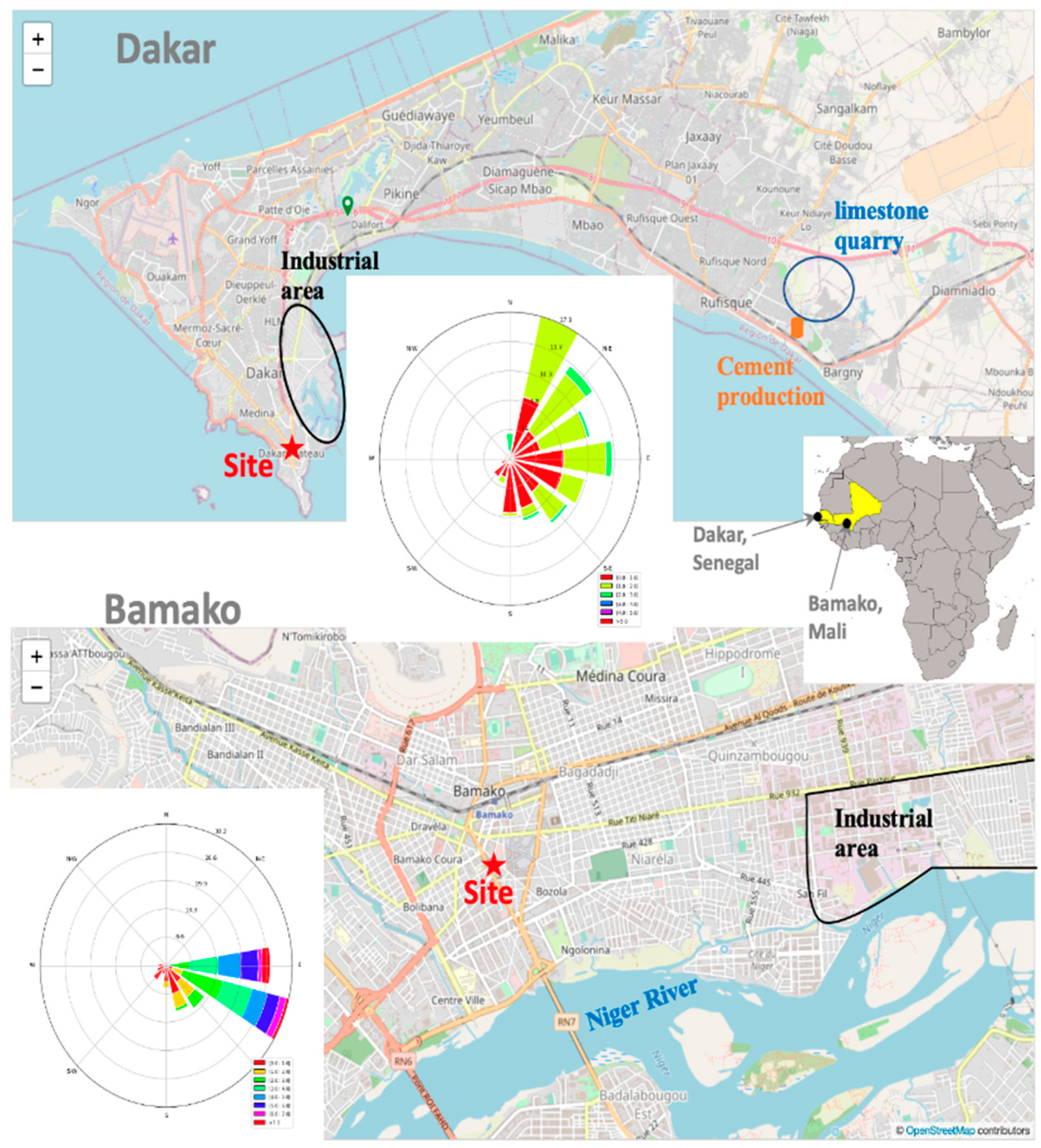
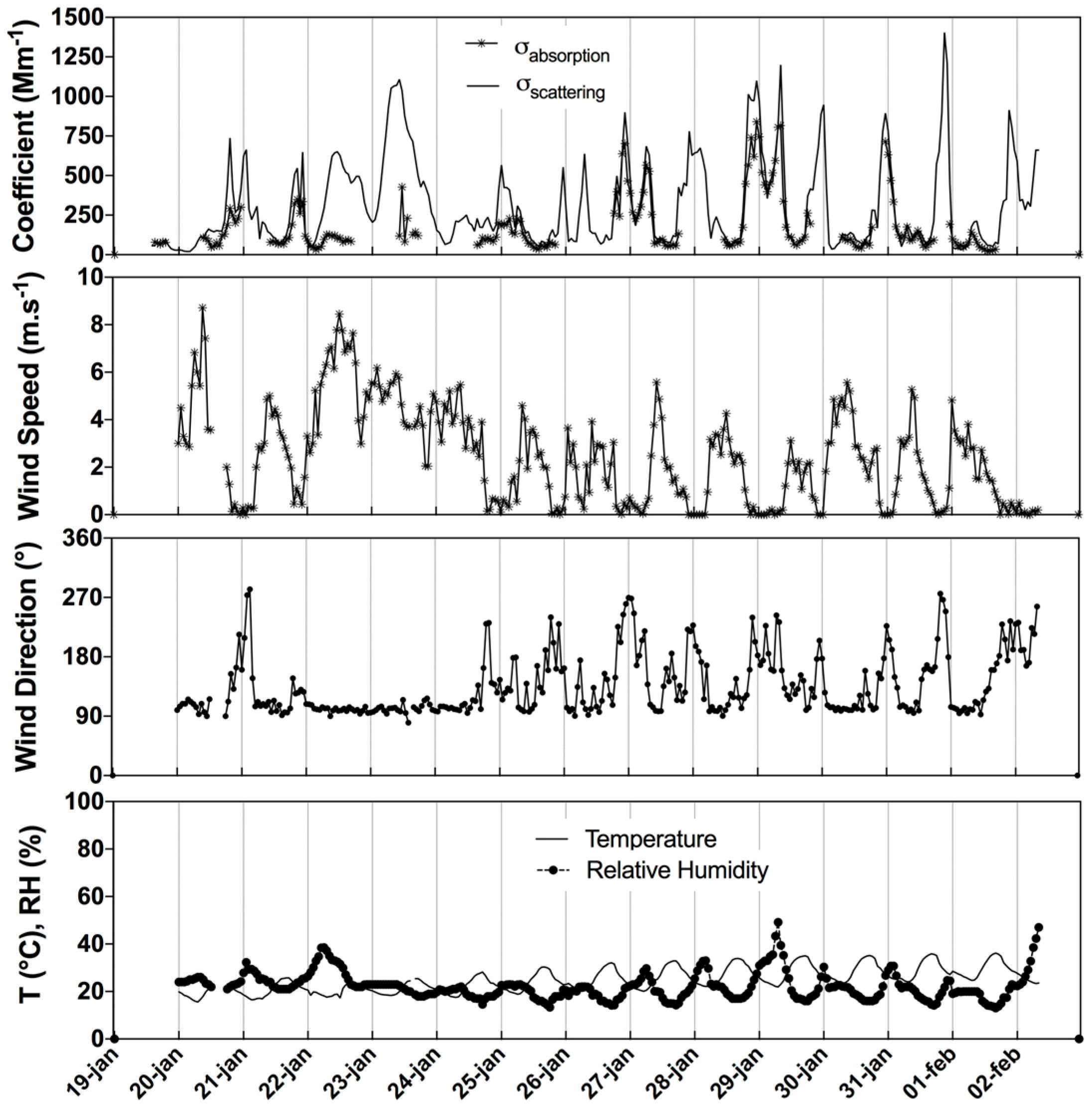
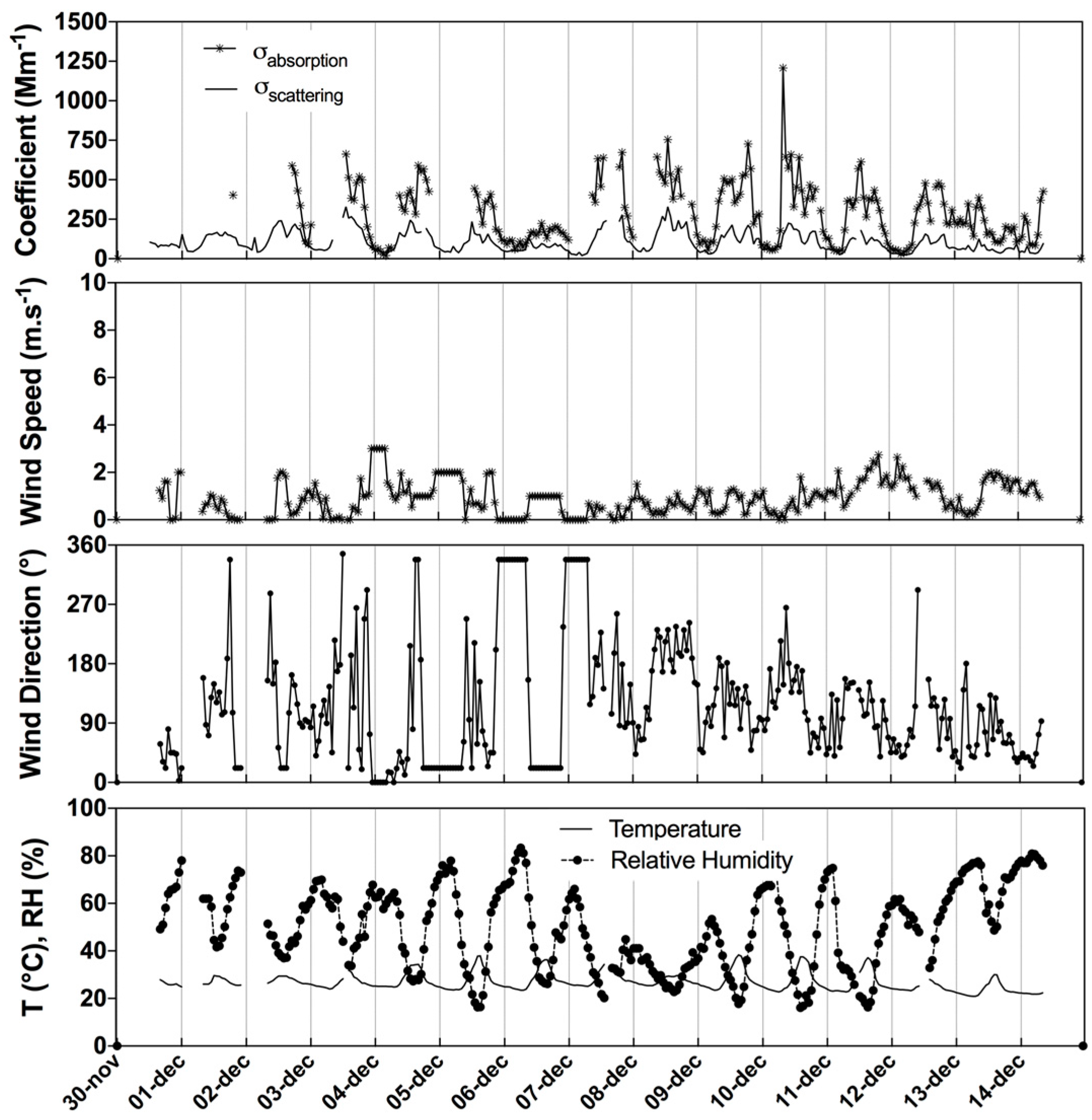
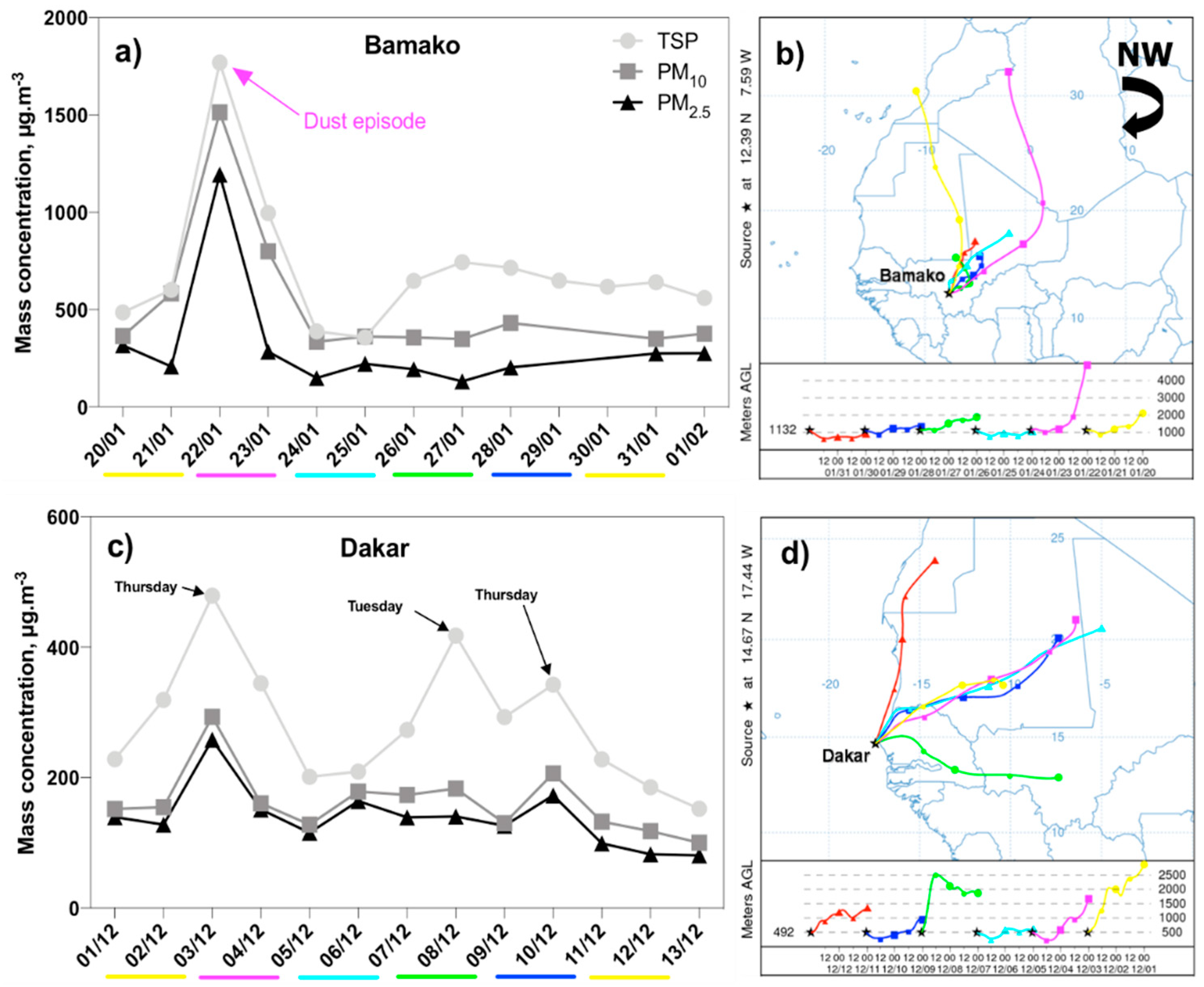
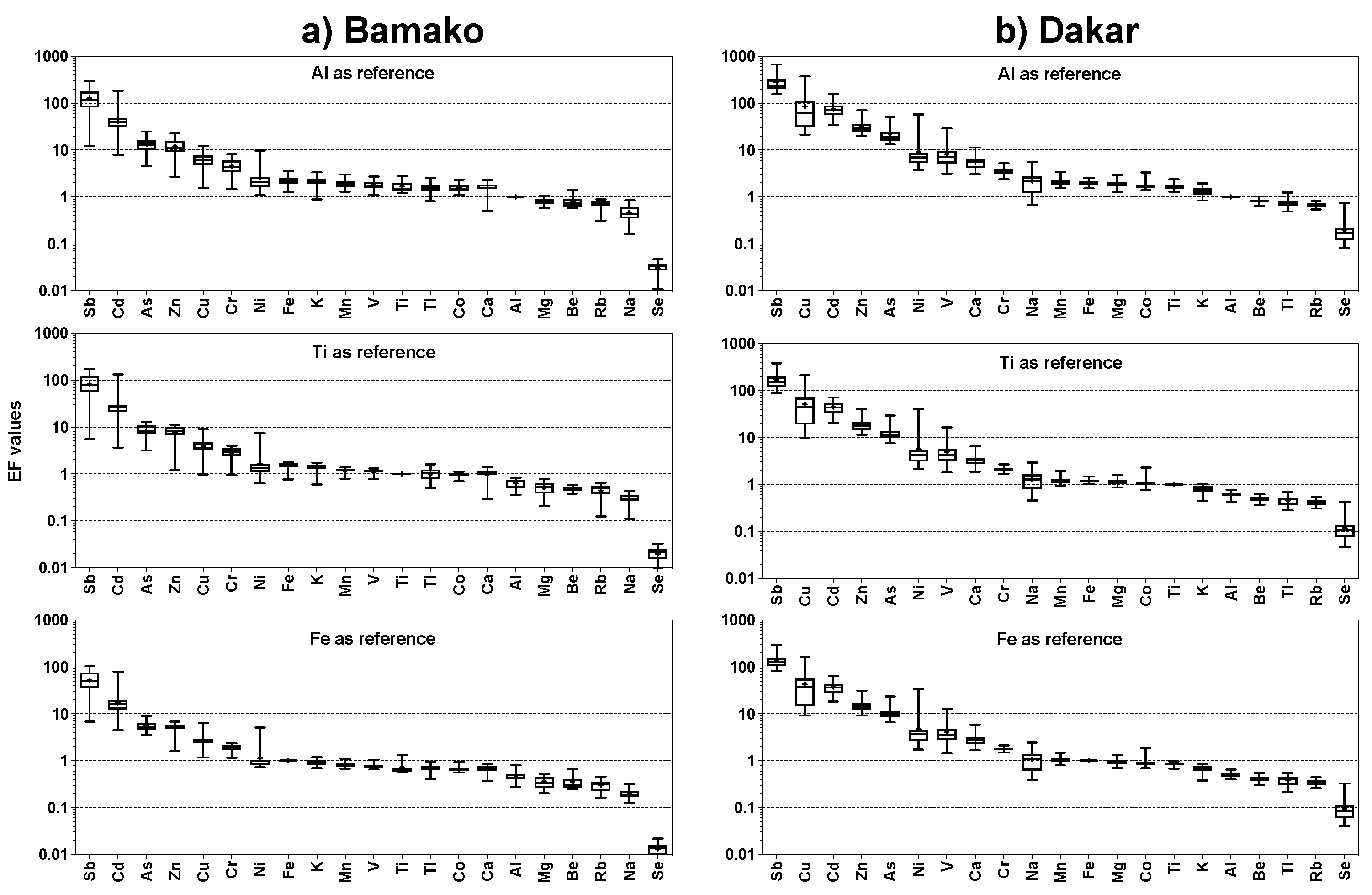
| Bamako | Dakar | |||||
|---|---|---|---|---|---|---|
| Species | TSP | PM10 | PM2.5 | TSP | PM10 | PM2.5 |
| Mass PM | 705.3 ± 99.3 | 503.6 ± 112.4 | 276.8 ± 94.7 | 274.9 ± 27.43 | 155.9 ± 15.7 | 138.2 ± 12.7 |
| Cl- | 3.43 (<1) | 3.36 (<1) | 2.12 (<1) | 8.45 (3) | 8.13 (5) | 1.77 (1) |
| NO3- | 1.87 (<1) | 1.87 (<1) | 1.18 (<1) | 2.06 (<1) | 2.31 (1) | 0.97 (<1) |
| SO42- | 4.44 (<1) | 4.29 (<1) | 2.98 (1) | 6.18 (2) | 7.49 (5) | 4.75 (3) |
| Na+ | 2.21 (<1) | 1.70 (<1) | 1.02 (<1) | 5.1 (2) | 5.04 (3) | 1.21 (<1) |
| K+ | 3.5 (<1) | 3.17 (<1) | 2.02 (<1) | 0.99 (<1) | 0.99 (<1) | 0.59 (<1) |
| Mg2+ | 0.87 (<1) | 0.75 (<1) | 0.49 (<1) | 0.72 (<1) | 0.71 (<1) | 0.28 (<1) |
| Ca2+ | 7.14 (1) | 7.09 (1) | 5.29 (2) | 12.17 (4) | 13.65 (9) | 11.43 (8) |
| Inorganic ions | 24.06 (3) | 22.99 (5) | 15.69 (6) | 36.09 (13) | 38.95 (25) | 21.50 (16) |
| BC | 23.34 (3) | 18.85 (4) | 27.11 (10) | 20.14 (7) | 16.41 (11) | 15.88 (11) |
| OC | 102.4 (15) | 82.38 (16) | 102.4 (37) | 69.19 (25) | 34.92 (22) | 35.83 (26) |
| TC | 125.74 (18) | 101.23 (20) | 129.51 (47) | 89.33 (32) | 51.33 (33) | 51.71 (37) |
| Al | 21.23 (3) | 22.24 (4) | 17.98 (6) | 9.66 (3) | 7.07 (4) | 4.11 (3) |
| Fe | 21.91 (3) | 20.41 (4) | 14.28 (5) | 9.00 (3) | 5.54 (3) | 3.49 (2) |
| Ti | 2.35 | 2.14 | 1.47 | 0.89 | 0.54 | 0.34 |
| Mn | 0.35 | 0.32 | 0.22 | 0.15 | 0.11 | 0.06 |
| Zn | 0.18 | 0.15 | 0.12 | 0.21 | 0.16 | 0.11 |
| Cr | 0.10 | 0.09 | 0.06 | 0.04 | 0.02 | 0.02 |
| V | 0.06 | 0.05 | 0.04 | 0.07 | 0.07 | 0.05 |
| Cu | 0.03 | 0.04 | 0.02 | 0.08 | 0.19 | 0.13 |
| Ni | 0.02 | 0.02 | 0.03 | 0.03 | 0.03 | 0.03 |
| Pb | 0.02 | 0.02 | 0.04 | 0.03 | 0.03 | 0.02 |
| Rb | 0.02 | 0.02 | 0.015 | 0.009 | 0.007 | 0.004 |
| Co | 0.009 | 0.008 | 0.005 | 0.004 | 0.002 | 0.0016 |
| Sb | 0.004 | 0.005 | 0.004 | 0.005 | 0.0044 | 0.0028 |
| As | 0.005 | 0.0045 | 0.003 | 0.003 | 0.0020 | 0.0014 |
| Be | 0.0008 | 0.0008 | 0.0005 | 0.0003 | 0.0002 | 0.0001 |
| Cd | 0.0007 | 0.0007 | 0.0008 | 0.0007 | 0.0006 | 0.0004 |
| Se | 0.0003 | 0.0003 | 0.0002 | 0.0007 | 0.0008 | 0.0005 |
| Tl | 0.0003 | 0.0003 | 0.0002 | 0.00005 | 0.00005 | 0.00003 |
| Metals | 46.29 (7) | 45.53 (9) | 34.29 (12) | 20.18 (7) | 13.78 (9) | 8.38 (6) |
| Bamako | Dakar | |||||||||
|---|---|---|---|---|---|---|---|---|---|---|
| PC1 | PC2 | PC3 | PC4 | PC5 | PC1 | PC2 | PC3 | PC4 | PC5 | |
| Eigenvalue | 15.386 | 3.180 | 1.284 | 1.228 | 1.012 | 17.126 | 3.231 | 1.560 | 1.137 | 1.107 |
| Variability | 56.986 | 11.777 | 8.459 | 8.251 | 7.452 | 63.431 | 11.967 | 5.776 | 4.210 | 4.100 |
| Cumulative | 56.986 | 68.763 | 77.222 | 85.472 | 92.924 | 63.431 | 75.398 | 81.174 | 85.384 | 89.484 |
| Factor loadings | ||||||||||
| Al | 0.982 | 0.051 | -0.041 | 0.035 | -0.120 | 0.688 | 0.334 | 0.300 | 0.341 | 0.385 |
| As | 0.938 | 0.143 | 0.206 | 0.099 | -0.111 | 0.154 | 0.177 | 0.470 | 0.577 | 0.245 |
| Be | 0.976 | 0.105 | -0.086 | 0.032 | -0.143 | 0.629 | 0.469 | 0.237 | 0.342 | 0.410 |
| Ca | 0.620 | 0.582 | 0.167 | 0.443 | 0.051 | 0.294 | 0.746 | 0.144 | 0.399 | 0.341 |
| Cd | 0.184 | -0.218 | 0.251 | 0.233 | 0.643 | 0.277 | 0.699 | 0.262 | 0.441 | 0.252 |
| Co | 0.972 | 0.143 | 0.015 | 0.086 | -0.121 | 0.542 | 0.347 | 0.225 | 0.407 | 0.596 |
| Cr | 0.830 | 0.291 | 0.358 | 0.232 | 0.074 | 0.509 | 0.158 | 0.259 | 0.428 | 0.658 |
| Cu | 0.642 | 0.291 | 0.512 | 0.276 | 0.089 | 0.097 | 0.360 | 0.312 | -0.729 | -0.107 |
| Fe | 0.964 | 0.181 | 0.085 | 0.129 | -0.068 | 0.653 | 0.293 | 0.351 | 0.465 | 0.362 |
| K | 0.370 | 0.879 | 0.041 | 0.236 | 0.051 | 0.702 | 0.415 | 0.357 | 0.253 | 0.282 |
| Mg | 0.920 | 0.241 | -0.069 | 0.181 | -0.105 | 0.620 | 0.297 | 0.441 | 0.453 | 0.306 |
| Mn | 0.974 | 0.130 | 0.001 | 0.079 | -0.123 | 0.594 | 0.425 | 0.319 | 0.481 | 0.318 |
| Na | 0.152 | 0.930 | 0.073 | 0.227 | 0.071 | 0.459 | 0.113 | 0.782 | 0.239 | 0.159 |
| Ni | 0.870 | 0.063 | -0.134 | 0.012 | 0.119 | -0.178 | -0.004 | -0.049 | -0.062 | 0.949 |
| Rb | -0.202 | -0.081 | 0.892 | 0.101 | 0.317 | 0.707 | 0.394 | 0.283 | 0.352 | 0.306 |
| Sb | 0.841 | 0.057 | 0.278 | 0.299 | 0.155 | 0.546 | 0.361 | 0.471 | -0.100 | 0.267 |
| Se | 0.977 | 0.107 | -0.056 | 0.036 | -0.134 | 0.170 | 0.363 | 0.657 | -0.319 | 0.376 |
| Ti | 0.980 | 0.038 | 0.095 | 0.078 | -0.013 | 0.663 | 0.352 | 0.282 | 0.424 | 0.385 |
| Tl | 0.980 | 0.124 | 0.014 | 0.076 | -0.104 | 0.612 | 0.534 | 0.184 | 0.191 | 0.402 |
| V | 0.264 | 0.414 | 0.698 | 0.294 | 0.301 | 0.346 | 0.636 | 0.342 | -0.161 | 0.381 |
| Zn | -0.481 | 0.201 | 0.143 | 0.045 | 0.753 | 0.477 | 0.659 | 0.338 | 0.289 | 0.173 |
| BC | -0.359 | 0.373 | 0.288 | -0.013 | 0.742 | 0.078 | 0.382 | 0.073 | 0.807 | 0.074 |
| OC | 0.187 | 0.349 | 0.443 | 0.728 | 0.213 | 0.472 | 0.078 | 0.117 | 0.789 | 0.091 |
| Cl- | 0.133 | 0.312 | 0.095 | 0.908 | 0.080 | 0.197 | 0.097 | 0.906 | 0.152 | -0.003 |
| NO3- | 0.889 | 0.230 | 0.004 | 0.284 | -0.058 | -0.112 | 0.382 | 0.832 | 0.021 | 0.196 |
| SO42- | 0.982 | 0.051 | -0.041 | 0.035 | -0.120 | -0.051 | 0.778 | 0.529 | -0.042 | 0.193 |
| Rotated | Potential Sources | Characteristic Compounds | |
|---|---|---|---|
| Bamako | PC1 | Dust | Al, As, Be, Cr, Co, Fe, Ti, Mg, Mn, V, Tl, Rb, Se, Ni, |
| PC2 | Solid fuel | Na, K, Ca, Zn, NO3-, Cl-, OC | |
| PC3 | Resuspended road | Sb, Zn, Cu, Cl-, Cr | |
| PC4 | Secondary aerosols | NO3-, Cl-, Ca | |
| PC5 | Vehicle | BC, OC, Cd, Zn | |
| Dakar | PC1 | Dust | Al, Be, Rb, K, Ti, Tl, Be, Fe, Mg, Co, Mn, Na, Sb, Cr, |
| PC2 | Industries, Oil | Ca, Cd, V, Zn, SO42-, Tl, K, Mn, Be, NO3-, BC, Ti, Al, | |
| PC3 | Salts | Na, Cl-, NO3-, Se, SO42-, As, K, Mg, Al, Cu, Fe, Mn, Sb, | |
| PC4 | Vehicle | BC, OC, Cd, Co, Cr, Fe, Mg, Mn, As, Al, Be, Ti, Ca, Rb | |
| PC5 | Resuspend road | Ni, Cr, Co, Be, Al, Tl, Ca, Fe, Mg, Mn, Rb, Se, Ti, V |
| Bamako | Factor 1 | Factor 2 | Factor 3 | Factor 4 | Factor 5 |
|---|---|---|---|---|---|
| PC1 | -0.72 | 0.00 | -0.07 | 0.84 | -0.06 |
| PC2 | -0.13 | -0.46 | 0.82 | -0.40 | 0.10 |
| PC3 | 0.30 | 0.71 | -0.13 | -0.63 | -0.07 |
| PC4 | -0.22 | 0.19 | -0.01 | -0.56 | 0.78 |
| PC5 | 0.81 | 0.13 | -0.17 | -0.70 | -0.05 |
| Dakar | Factor 1 | Factor 2 | Factor 3 | Factor 4 | Factor 5 |
| PC1 | -0.24 | 0.14 | -0.33 | 0.84 | -0.34 |
| PC2 | -0.32 | -0.13 | -0.18 | 0.28 | 0.57 |
| PC3 | 0.89 | -0.38 | -0.34 | -0.33 | 0.05 |
| PC4 | -0.16 | 0.78 | -0.15 | 0.28 | -0.72 |
| PC5 | -0.35 | -0.11 | 0.57 | 0.32 | -0.38 |
Disclaimer/Publisher’s Note: The statements, opinions and data contained in all publications are solely those of the individual author(s) and contributor(s) and not of MDPI and/or the editor(s). MDPI and/or the editor(s) disclaim responsibility for any injury to people or property resulting from any ideas, methods, instructions or products referred to in the content. |
© 2023 by the authors. Licensee MDPI, Basel, Switzerland. This article is an open access article distributed under the terms and conditions of the Creative Commons Attribution (CC BY) license (http://creativecommons.org/licenses/by/4.0/).




